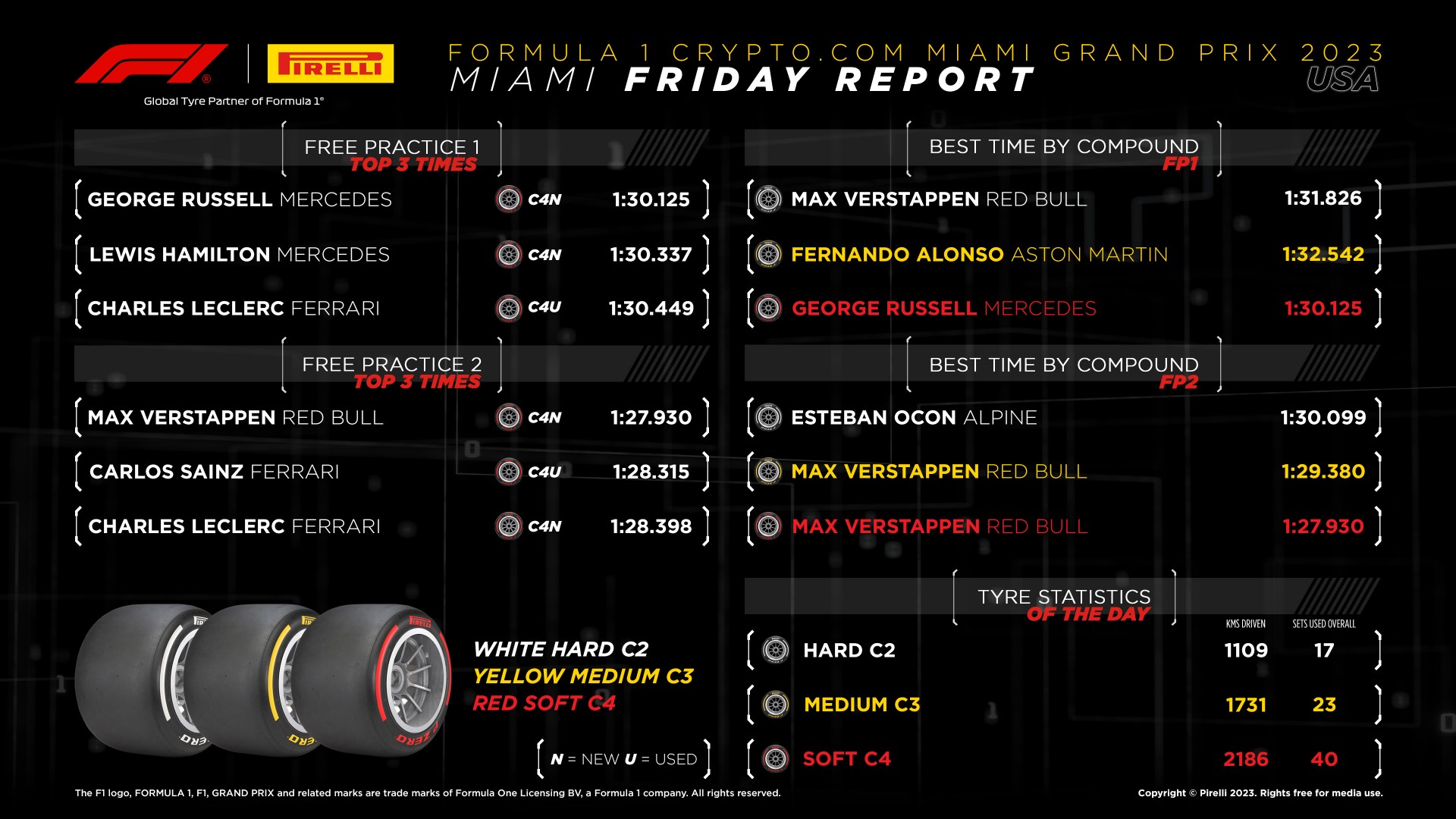2023 Miami Grand Prix - Friday
WHAT WE LEARNED
- Red Bull driver Max Verstappen broke the current lap record on the first day of free practice at the Miami Autodrome. The Dutchman set a best time of 1m27.930s in FP2: 0.866s faster than the pole position claimed by Ferrari’s Charles Leclerc last year and two seconds faster than the best Friday time from 2022 – 1m29.938s – set by Mercedes driver George Russell. Leclerc was third-fastest in FP2 this year with a 1m28.398s before ending up in the barriers at Turn 7, with about 10 minutes of the session left to go. His team mate Carlos Sainz ended up second-fastest in the session with a 1m28.315s: the only driver in top three to set his best time on a used set of P Zero Red soft tyres.
- Ambient temperatures peaked at more than 34 degrees centigrade in FP1, never dropping below 28 degrees centigrade all day. Track sensors registered an average asphalt temperature of 53 degrees in FP1, which dropped by 16 degrees over the course of the afternoon: with an average of 36.5 degrees in FP2.
- Mercedes set the pace in FP1 on new softs, with George Russell laying down a marker of 1m30.125s, 0.212s ahead of his team mate Lewis Hamilton. Leclerc was third with a 1m30.449s. The red flags came out halfway through the session after Haas driver Nico Hulkenberg spun and hit the barriers.
- Verstappen set not only the fastest time and overall lap record with the soft tyre, but he was also the quickest driver on the P Zero Yellow medium with a time of 1m29.380s. Alpine’s Esteban Ocon claimed the best time on the P Zero White hard: 1m30.099s.

“We saw two very intense hours of free practice today around the Hard Rock Stadium in Miami. The new asphalt and how it would affect the cars was one of the biggest unknown factors heading into the event. As we’ve seen at previous races, the 2023 cars have shown themselves to be considerably quicker than last year’s equivalents: it’s no coincidence that today’s fastest time is a good nine-tenths faster than last year’s pole. So we can expect another notable step forwards tomorrow in terms of lap time compared to simulations, based on the information we have from the teams. The new asphalt is very smooth and slippery, offering little mechanical grip but at the same time good adhesion, which increasingly improved as conditions got better. On top of the increase in car performance this year, this led to some overheating on the rear tyres. There was also graining seen on the medium and soft, not only on the rear tyres but also on the fronts, which are heavily worked at this circuit. The hard tyres showed themselves to be very consistent. We’ll see how the track improves tomorrow, taking weather conditions into account as well. Cloudier skies are expected, with a significant possibility of rain on Sunday.”
Founded in 1872, Pirelli is a company with deep Italian roots now recognised all over the world for its cutting-edge technology, capacity for innovation, and the quality of its products. Motorsport has always played an important part in Pirelli’s strategy, following the ‘race to road’ philosophy. The company has been engaged in motorsport for 116 years and today supplies tyres to more than 350 championships on both two and four wheels. Pirelli pays constant attention to the most efficient use of natural resources and energy, and will reach carbon neutrality by 2030.
Pirelli has been Global Tyre Partner of the FIA Formula 1 World Championship since 2011. The company also supplies championships including FIA Formula 2, FIA Formula 3, Formula Regional European Championship by Alpine, FIA World Rally Championship and GT World Challenge, alongside numerous national series.




















